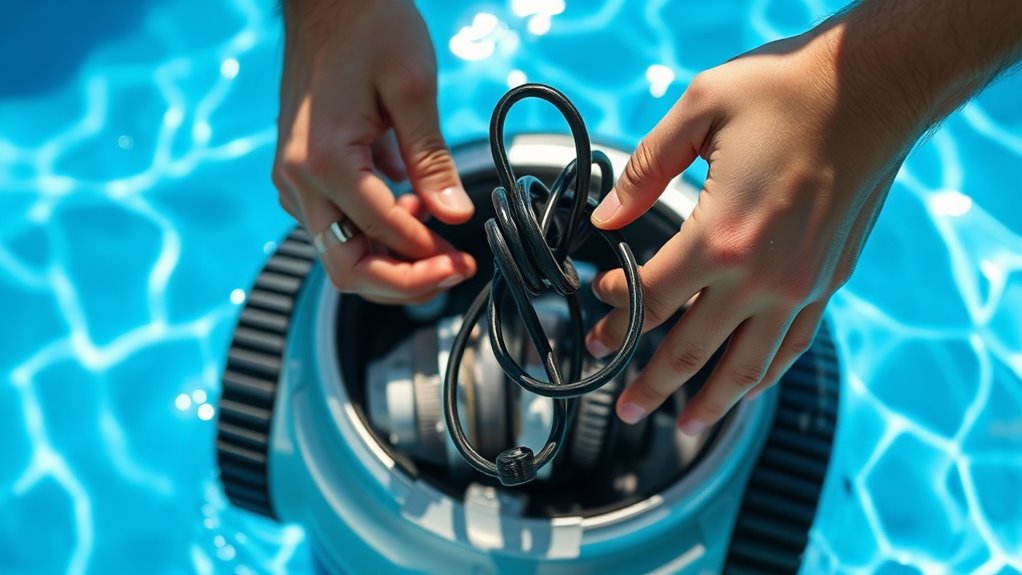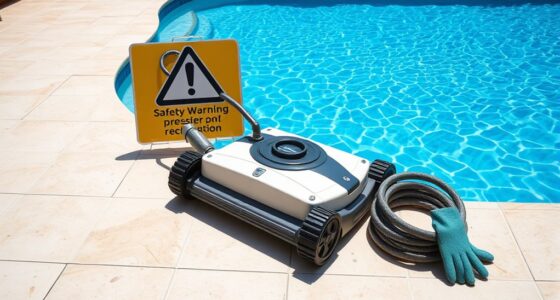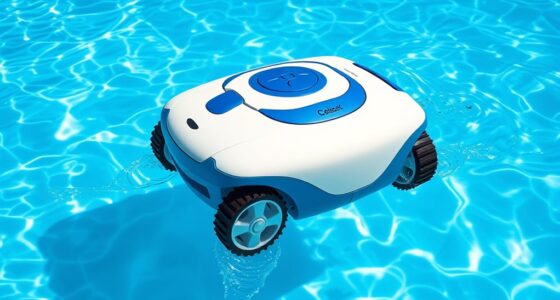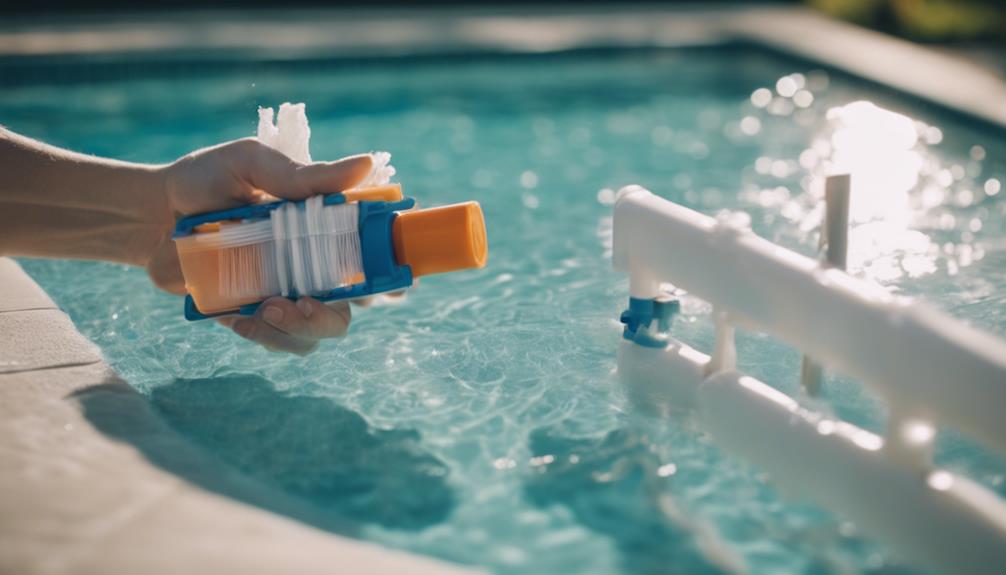To troubleshoot your automatic pool cleaner, start by checking that it’s plugged into a proper outlet and that all connections are secure. Inspect brushes, tracks, hoses, and seals for wear or blockages, and clean or replace as needed. Confirm the pool’s water level is correct and the surface is clear of debris. Reset the system if it stalls and verify all cables are intact. Keeping your cleaner maintained will help it work smoothly—continue exploring for more tips.
Key Takeaways
- Check electrical connections, power source, and reset the system if the cleaner is unresponsive.
- Inspect brushes, tracks, and drive components for wear, debris, or damage; clean or replace as needed.
- Ensure all hoses, cables, and seals are secure, intact, and free from cracks to prevent leaks and loss of suction.
- Verify water flow, chemical balance, and water level to optimize cleaner performance and prevent malfunctions.
- Perform routine maintenance, including cleaning, sanitizing, and storing components properly after use or season.
Checking the Power Source and Connections

Before troubleshooting your pool cleaner, make sure it’s properly connected to a power source. Electrical safety is vital, so verify the outlet is functioning correctly and that there are no frayed or damaged cords. Check if the power cord is firmly plugged in and free of visible damage. If your cleaner isn’t turning on, consider replacing the power cord if it shows signs of wear or damage. Always unplug the unit before inspecting or replacing the cord to prevent electric shock. Use a voltage tester to confirm the outlet’s power if necessary. Proper connections are essential for safe operation and effective cleaning. If replacing the power cord, follow manufacturer instructions to ensure a secure fit and maintain electrical safety standards. Additionally, ensuring the electrical system in your area is up to code can prevent potential power issues affecting your cleaner. Regularly inspecting your electrical connections can help identify problems early and ensure your pool cleaner operates smoothly. Ensuring your power supply is stable can also prevent unexpected shutdowns and improve overall efficiency. Incorporating a ground-fault circuit interrupter (GFCI) can further enhance safety by cutting off power during electrical faults. Furthermore, checking the circuit breaker can help prevent overloads that might disrupt your cleaner’s operation.
Inspecting and Cleaning the Brushes and Brushes Tracks
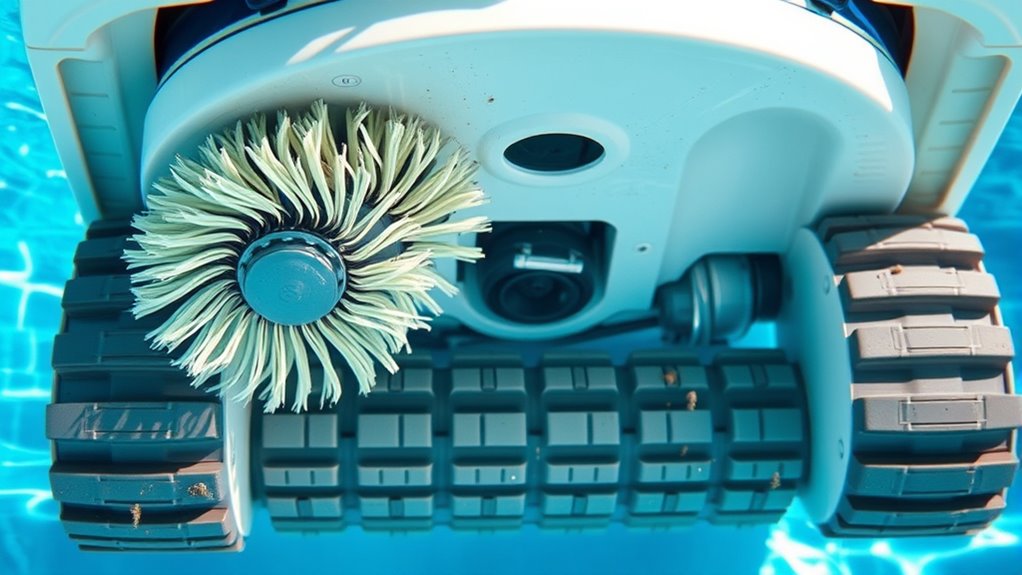
Inspecting and cleaning the brushes and brush tracks is a crucial step to guarantee your pool cleaner works efficiently. Start with a thorough brush inspection to check for signs of wear, cracks, or buildup that could hinder performance. Remove debris or algae from the brushes to ensure proper contact with the pool surfaces. Next, focus on track cleaning—use a soft brush or cloth to clear dirt, algae, or obstructions from the tracks. Dirty or worn brushes and muddy tracks can cause the cleaner to miss spots or move unevenly. Regular maintenance keeps the brushes flexible and tracks free of debris, improving overall cleaning efficiency. Incorporating these steps into your routine helps prevent malfunctions and extends the lifespan of your automatic pool cleaner. Additionally, understanding the importance of proper maintenance can help you keep your pool cleaner in optimal condition for longer periods. Routine inspections and cleaning also contribute to preventing equipment failure, ensuring your cleaner continues to operate effectively. Proper component care is essential for maintaining peak performance and avoiding costly repairs.
Examining the Skimmer and Hose for Blockages
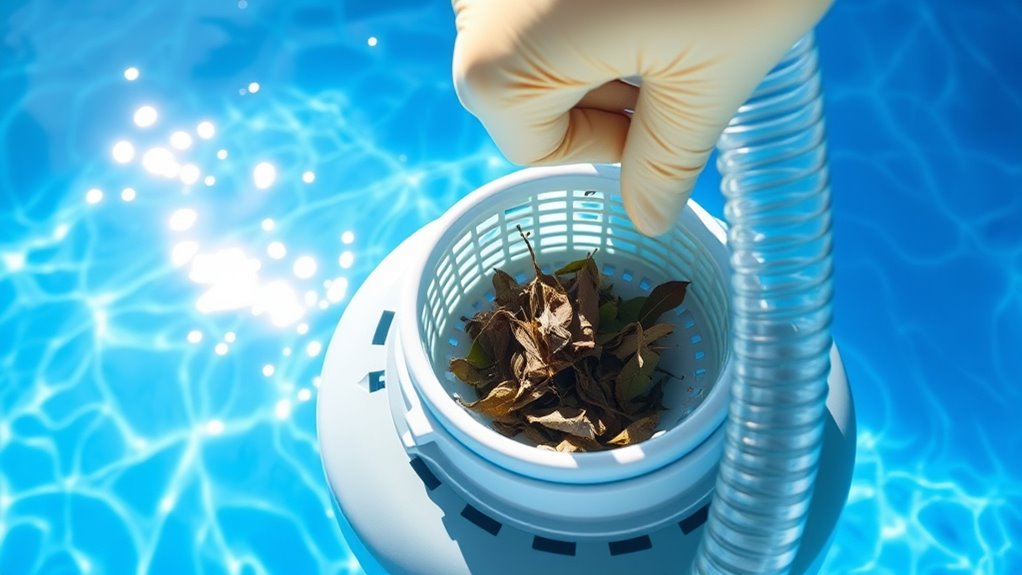
Start by inspecting the skimmer basket to see if it’s full or clogged, which can hinder water flow. Next, check the hose for any blockages or kinks that might restrict suction. Clearing these obstructions helps guarantee your pool cleaner operates efficiently. Additionally, ensure the hose connections are secure and free of leaks to maintain optimal suction power. Regularly inspecting the filter system can also prevent debris buildup that affects performance. Being aware of pinball machine weight is important if you need to move your pool cleaner or store it away. Proper maintenance of these components is essential for automatic pool cleaner longevity and effectiveness.
Inspect Skimmer Basket
Have you checked the skimmer basket recently? A clogged skimmer basket can hinder your pool cleaner’s performance. Remove the basket carefully and inspect it for debris buildup. Clear out any leaves, dirt, or small debris to ensure smooth water flow. Regular debris removal keeps your cleaner working efficiently and prevents damage. Incorporating energy-efficient water systems can also help maintain optimal water circulation in your pool. Additionally, maintaining proper filtration systems is crucial for preventing clogs and ensuring your pool cleaner functions properly. Paying attention to home decor elements can also create a more inviting poolside environment that complements your cleaning routine. Understanding how angel number soulmate patterns relate to your relationship can also bring peace of mind, especially during maintenance routines. Remember, a well-maintained basket is key to preventing future issues with your automatic pool cleaner. Proper routine maintenance can extend the lifespan of your equipment and keep it operating smoothly.
Check Hose for Clogs
To guarantee your pool cleaner works effectively, it’s vital to inspect the hose and skimmer for any clogs or obstructions. Start with a thorough hose inspection, checking for debris or obstructions that can hinder water flow. Remove any visible debris and gently straighten the hose to identify hidden clogs. If water isn’t flowing freely or the cleaner isn’t moving properly, a clog might be the cause. To perform clog removal, detach the hose sections and flush them with water to clear out debris. Also, inspect the skimmer for any blockages that could restrict water intake. Clearing these obstructions ensures proper suction and peak cleaning performance. Regularly checking your hose and skimmer prevents issues and keeps your automatic pool cleaner running smoothly. Understanding the importance of mental wellbeing can also help maintain a positive mindset during routine maintenance.
Verifying the Cables and Cord Integrity
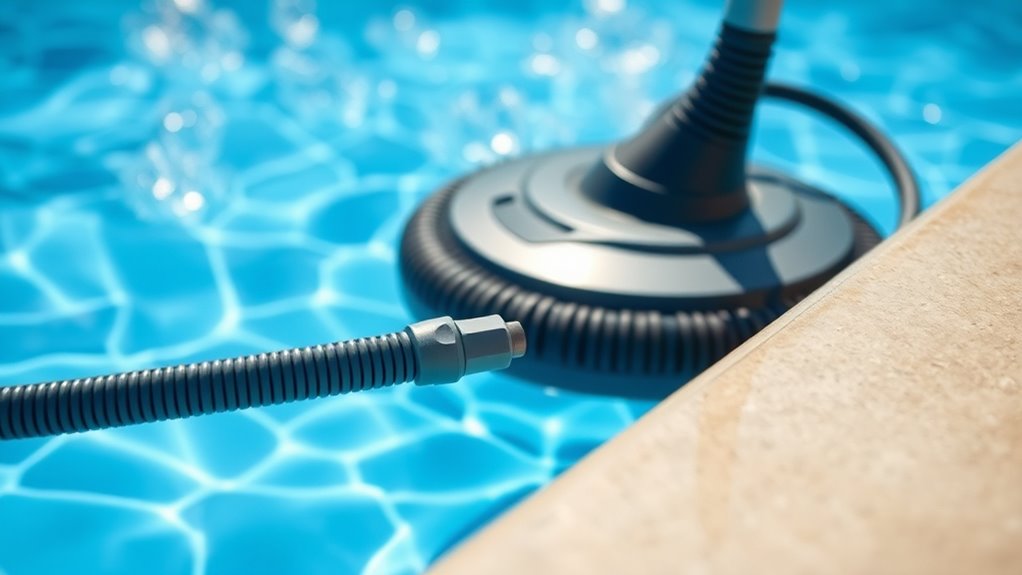
Start by checking all cable connections to make sure they’re secure and properly plugged in. Look for any signs of wear, fraying, or damage along the cords that could affect performance. Also, verify that the cord is routed correctly to prevent tangling or strain during operation. Regularly inspecting and maintaining system integrity helps ensure your pool cleaner operates efficiently and prolongs its lifespan. Additionally, ensuring proper electrical grounding can prevent malfunctions and enhance safety during use.
Inspect Cable Connections Carefully
Before troubleshooting your pool cleaner, it’s essential to carefully inspect the cable connections. Start by checking all cable connections for proper fit and secure attachment. Loose or poorly connected cables can disrupt power flow and cause the cleaner to malfunction. During cable maintenance, ensure that connectors are compatible with your specific model; incompatible or damaged connectors can lead to connectivity issues. Avoid forcing connections that don’t fit properly, as this can damage the connectors or wiring. Look for corrosion, cracks, or signs of wear at connection points, which can interfere with electrical signals. By verifying connector compatibility and ensuring tight, clean connections, you reduce the risk of problems related to cable integrity, helping your pool cleaner operate smoothly and efficiently.
Check for Wear or Damage
Inspect your pool cleaner’s cables and cords closely for signs of wear or damage, as these issues can disrupt its operation. During wear inspection, look for frayed wires, cuts, or exposed insulation that could cause malfunction. Damaged cords may also interfere with proper filter maintenance, reducing cleaning efficiency. To ensure the cords are in good shape, check for the following:
- Cracks or splits in the insulation
- Loose or corroded connections
- Twisted or kinked sections that hinder movement
- Signs of electrical burn or melting near connectors
Address any damage immediately to prevent further issues. Regular wear inspection helps maintain peak performance and extends your cleaner’s lifespan, ensuring it operates smoothly and effectively.
Ensure Proper Cord Placement
Ensuring your pool cleaner’s cords are properly placed is essential for smooth operation and effective cleaning. Start by checking the cord placement to prevent tangles or knots, which can hinder movement. Proper cable routing is vital; keep the cable straight and avoid sharp bends that could cause damage or interfere with the cleaner’s navigation. Make certain the cable is securely attached to the cleaner and the pool’s wall or anchor point without slack that could cause looping. Regularly inspect the cable for signs of wear or damage, and replace any frayed or broken sections. Well-managed cable routing reduces tangling and prolongs the life of your cleaner, guaranteeing it moves freely across your pool’s surface and performs at its best.
Assessing the Pool’s Water Level and Surface Conditions

A proper water level is essential for your pool cleaner to operate effectively, as it directly impacts the suction and movement of the cleaner. If the water’s too low, the cleaner may lose suction; too high, and it could float or miss areas. To assess surface conditions, start with these steps:
Maintaining the correct water level is key for optimal pool cleaner performance and effective surface cleaning.
- Check the water level, ensuring it’s mid-skimmer opening.
- Examine the water chemistry, maintaining proper alkalinity and pH for algae control.
- Look for surface debris or algae buildup, which can hinder cleaning.
- Observe the water’s clarity and surface smoothness, indicating balanced water conditions.
Adjust the water level if needed, and perform regular water chemistry tests. Maintaining proper water conditions ensures your cleaner functions ideally and helps prevent algae growth.
Troubleshooting the Drive System and Wheels

If your pool cleaner isn’t moving smoothly or seems stuck, the drive system and wheels are likely the culprits. Check the drive motor for obstructions or damage, as it powers the wheels. Also, ensure the wheels are properly aligned; misalignment can cause the cleaner to get stuck or move erratically. Here’s a quick overview:
| Issue | Solution |
|---|---|
| Drive motor not running | Inspect for debris and test motor function |
| Wheels out of alignment | Adjust wheel positions for even contact |
| Wheels stuck or jammed | Clean debris from wheels and axles |
| Unusual noises | Check for worn or damaged parts |
| Inconsistent movement | Verify drive motor operation and alignment |
Regular maintenance of the drive system keeps your cleaner functioning efficiently.
Resetting the Cleaner and Power Supply
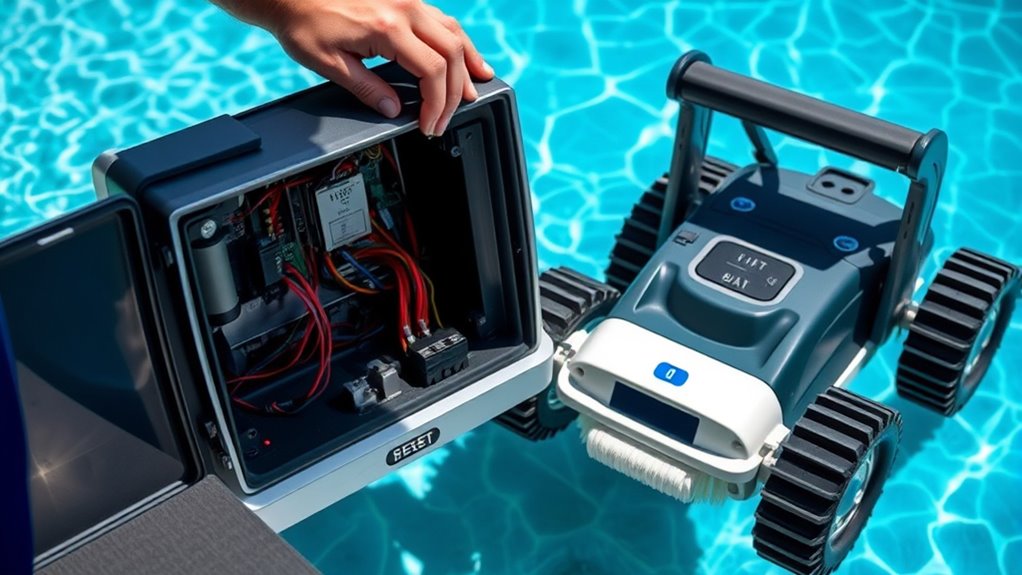
To get your pool cleaner working smoothly again, start by performing a power cycle—turn the unit off, wait a few seconds, and turn it back on. Next, reset the controller to clear any glitches that might be causing issues. Finally, double-check all connections to make certain they’re secure and plugged in properly.
Power Cycle Procedure
Have you tried power cycling your pool cleaner and its power supply to resolve operational issues? This simple step can improve energy efficiency and guarantee user safety. To do it correctly:
- Turn off the power supply at the circuit breaker or disconnect the power cord.
- Wait 30 seconds to allow residual energy to dissipate.
- Reconnect or turn on the power supply.
- Observe the cleaner for proper startup and operation.
Power cycling resets internal components, helping fix minor glitches without risking damage. It’s a quick way to troubleshoot before more complex repairs. This process not only enhances energy efficiency but also maintains safety by eliminating potential electrical faults. Always follow manufacturer instructions, and guarantee the power is completely off before handling equipment. This simple step can save you time and keep your pool cleaner functioning optimally.
Resetting the Controller
Wondering how to reset your pool cleaner’s controller effectively? First, turn off the power supply, then unplug the cleaner’s main unit. Wait a few minutes to allow any residual charge to dissipate. While the system is off, check your pool chemistry—imbalances can affect controller performance—so balance chemicals if needed. During seasonal maintenance, reset the controller to clear any error codes or glitches caused by temperature or chemical fluctuations. Press and hold the reset button, if available, or disconnect and reconnect the power to reboot the system. This process helps recalibrate the controller, ensuring it communicates properly with the cleaner. After resetting, power everything back on and observe the system to confirm it’s functioning correctly. Properly resetting the controller can resolve many common operational issues.
Ensuring Proper Connections
After resetting the controller, it’s important to verify that the cleaner and power supply are properly connected to prevent future issues. Proper connections guarantee ideal performance and avoid troubleshooting delays. First, check that the power cord is securely plugged into both the outlet and the cleaner. Next, confirm that the transformer or control box is properly connected to the cleaner and the power source. Third, inspect the cables for any damage or corrosion, especially if water temperature management has caused condensation. Lastly, verify that the pool’s chemical balance is maintained, as imbalanced chemicals can affect electrical components. Also, ensure water temperature stays within the cleaner’s recommended range, preventing malfunctions. These steps help keep your cleaner running smoothly, reducing the risk of connection-related failures.
Ensuring Proper Navigation and Obstacle Avoidance
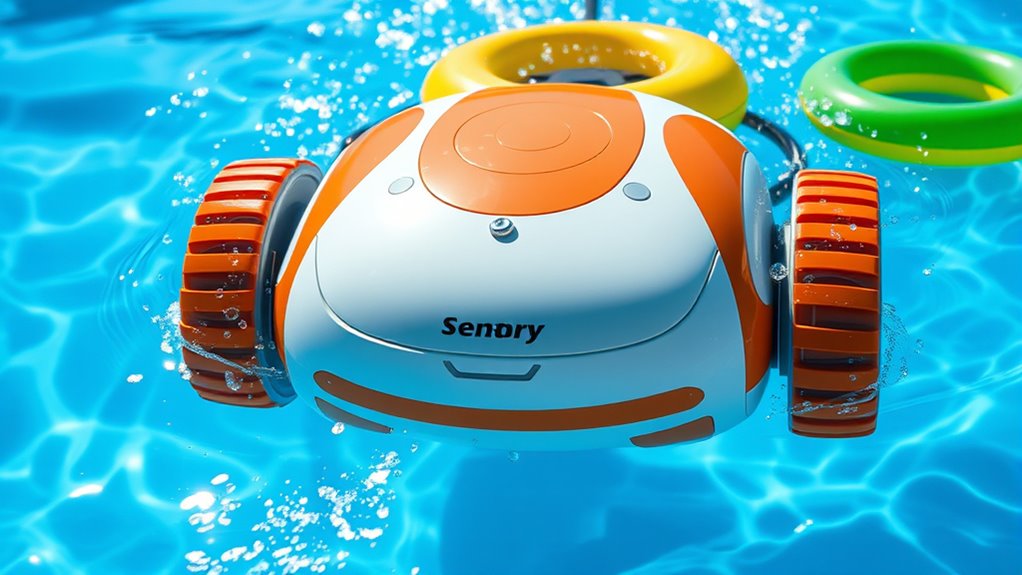
To guarantee your pool cleaner navigates efficiently and avoids obstacles, you need to understand how its sensors and programming work together. Navigation algorithms guide the cleaner’s movements, ensuring it covers the entire pool surface systematically. Obstacle detection sensors play a vital role by immediately identifying objects like steps, ladders, or pool toys. When an obstacle is detected, the cleaner adjusts its path to prevent collisions or getting stuck. Regularly cleaning or recalibrating these sensors ensures they function correctly. If your cleaner seems to get stuck or misses areas, troubleshooting the navigation algorithms and obstacle detection systems can resolve the issue. Properly functioning sensors and smart programming help your cleaner navigate smoothly, saving time and ensuring your pool is thoroughly cleaned.
Replacing Worn or Damaged Parts

Worn or damaged parts can hinder your pool cleaner’s performance, causing it to miss areas or get stuck more often. To restore efficiency, inspect and replace key components such as the brushes, wheels, hoses, or seals. When doing so, keep these steps in mind:
- Check for cracks or tears in hoses and replace if needed.
- Replace worn brushes or tracks to improve movement.
- Ensure seals are intact to prevent leaks affecting suction.
- Confirm that all connections are secure for maximum cleaning.
Maintaining Regular Cleaning and Storage Practices
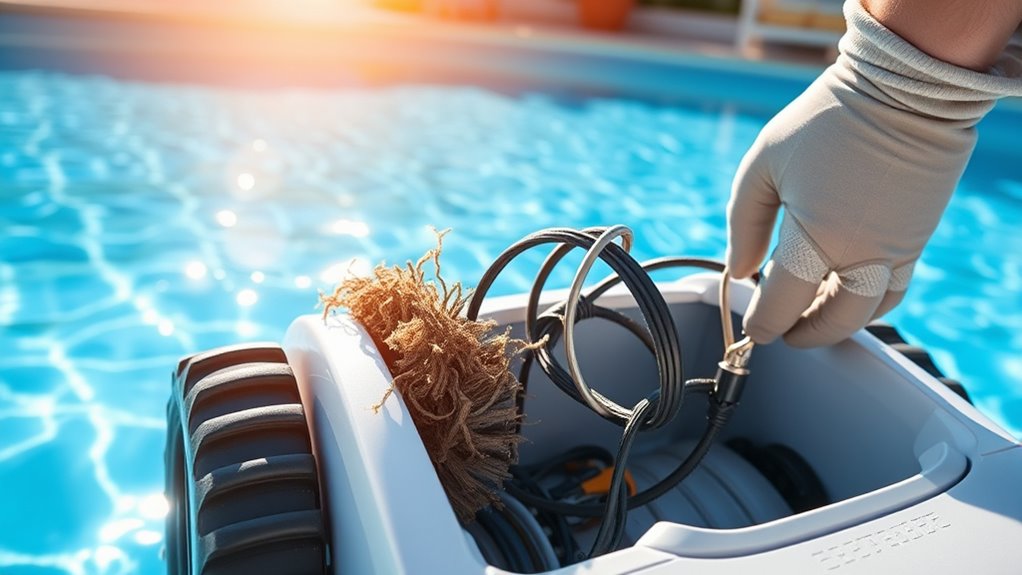
Regular cleaning and proper storage are essential to keep your pool cleaner functioning at its best. After each use, rinse the cleaner thoroughly to remove debris and sanitize components, preventing buildup that can impair performance. Check the pool’s chemical balance regularly; a proper pool chemical balance ensures your cleaner operates efficiently and reduces wear. When seasonal storage tips come into play, clean and dry your cleaner completely before storing it in a cool, dry place. Store hoses and brushes neatly to avoid tangling or damage. Proper storage protects your equipment from harsh weather and prolongs its lifespan. By maintaining these practices, you minimize issues and keep your automatic pool cleaner ready for ideal performance season after season.
Frequently Asked Questions
How Do I Program My Automatic Pool Cleaner for Optimal Coverage?
To program your automatic pool cleaner for ideal coverage, start by adjusting the programming settings based on your pool’s shape and size. Guarantee the cleaner’s pattern covers all areas evenly by selecting the appropriate cycle duration and mode. Regularly check the settings and make small adjustments if you notice missed spots. Proper programming and coverage optimization help your cleaner work efficiently, saving you time and ensuring a spotless pool.
Can Algae or Debris in the Pool Affect the Cleaner’S Performance?
Algae buildup and debris accumulation can definitely affect your pool cleaner’s performance. When algae or debris clog the brushes or filters, the cleaner might struggle to move efficiently or miss spots. Regularly removing algae and debris keeps your cleaner working smoothly, ensuring ideal coverage. Make sure to clean or replace filters often, and skim the surface daily to prevent buildup that could hinder your cleaner’s ability to keep your pool pristine.
What Is the Recommended Lifespan for Parts Like Brushes and Tracks?
You might wonder about the lifespan of your cleaner’s brushes and tracks, but proper maintenance helps them last longer. Typically, brushes last around 6 months, and tracks can go up to a year with good care. Regularly check your pool chemistry to prevent buildup that can wear parts prematurely. Always prioritize electrical safety by unplugging your cleaner during maintenance, ensuring safe handling and peak performance.
How Do Weather Conditions Impact the Cleaner’s Operation?
Weather impact and climate considerations can greatly affect your automatic pool cleaner’s operation. Extreme temperatures, heavy rain, or strong winds may hinder its performance or cause damage. Cold weather can stiffen parts, while excessive heat might lead to overheating. Windblown debris can clog filters or tracks. To guarantee ideal function, regularly inspect your cleaner, adjust for seasonal changes, and store it properly during harsh weather conditions.
Are There Safety Precautions to Consider When Troubleshooting?
When troubleshooting your pool cleaner, prioritize safety by wearing safety gear, avoiding electrical hazards, and disconnecting power before inspection. Protect yourself with gloves, goggles, and insulated tools. Guarantee electrical safety by turning off the power supply, preventing shocks or shorts. Keep the area dry, stay alert for exposed wiring, and never attempt repairs with wet hands. Safety always comes first, so take precautions to prevent accidents and ensure smooth troubleshooting.
Conclusion
By following these troubleshooting tips, you’ll keep your automatic pool cleaner running smoother than a dolphin gliding through crystal-clear waters. Regular maintenance and quick checks prevent issues from turning into a full-blown pool disaster. Don’t let a minor glitch turn your backyard oasis into a swamp—act now, stay vigilant, and enjoy pristine, sparkling water all season long. Your pool’s perfect cleanliness depends on your prompt attention—so get to it and keep that cleaner purring like a satisfied cat!

